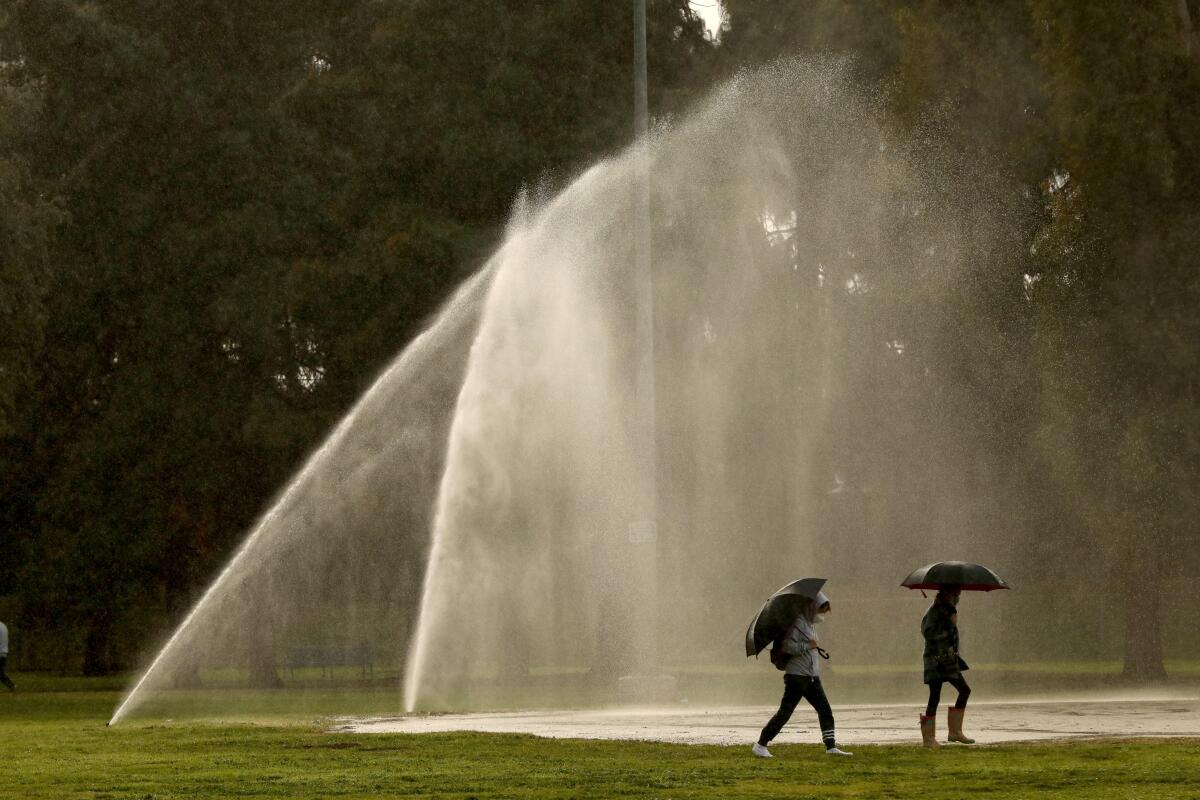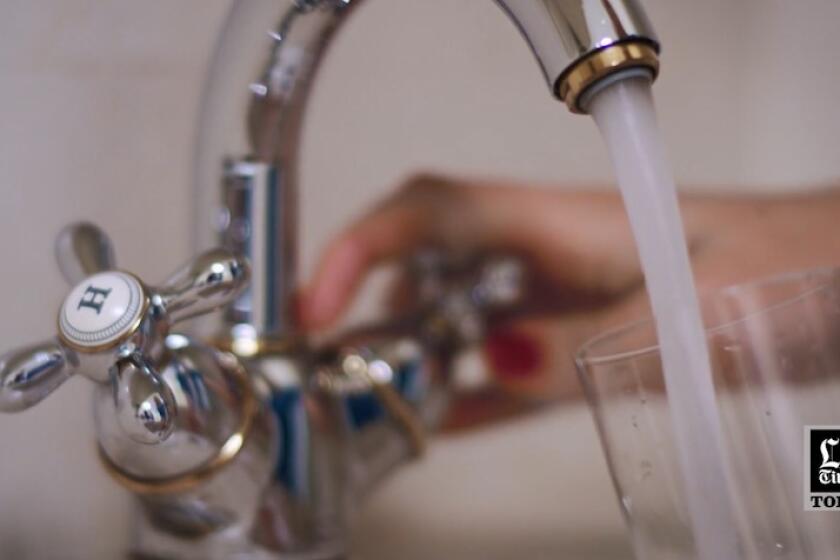As drought deepens, Californians are saving less water

- Share via
California will end winter in a perilous position as record-shattering dryness converges with lagging water conservation efforts in nearly every part of the state, officials said Tuesday.
After months of cutting back, new data from the State Water Resources Control Board show that rather than conserving water, Californians increased urban water use 2.6% in January, compared to the same month in 2020 — the baseline year against which current savings are measured.
The cumulative savings from July — when Gov. Gavin Newsom called on Californians to voluntarily cut water use by 15% — to the end of January were just 6.4%, less than half the target. Officials said more must be done to prevent worst-case drought scenarios, including increased restrictions and mandatory water cuts.
“These numbers are a good wake-up call that we need to buckle up and get going,” conservation supervisor Charlotte Ely told reporters Tuesday morning.
The numbers hearken back to California’s punishing 2012-2016 drought, when then-Gov. Jerry Brown ordered a mandatory 25% reduction in urban water use. Californians came close to meeting that goal, and many of their water-saving habits remain.
But conditions today are more extreme than even those dire times. January and February, typically the heart of California’s wet season, were the driest ever recorded, with only about three-quarters of an inch of precipitation, said state climatologist Michael Anderson. The next lowest, 2013, saw about twice that amount.
As drought persists, Californians reduced water use 3.9% in September. That reduction was smaller than in August, when Californians used 5% less.
Despite the dwindling numbers, some experts said the state’s water managers haven’t done enough to prepare for and respond to the current conditions.
“I think mandatory cuts are not only warranted — I think they’re long overdue,” said hydrologist Peter Gleick, co-founder of the Pacific Institute. “The reservoirs are lower than they were at this time last year, and last year we were in the second year of the drought.”
During a board meeting Tuesday, Department of Water Resources Director Karla Nemeth said California needs to receive about four more inches of precipitation before month’s end or it will end up being the driest January-February-March stretch on record — an increasingly likely scenario.
“It’s really turned into a very difficult year,” Nemeth said, adding that although the state typically relies on a slow accretion of reservoir inflows through summer, “it’s entirely possible that our inflows will have already peaked.”
As a result, the department is planning to announce a reduction in the promised 15% water supply allocation that came on the heels of December’s storms, Nemeth said, although she did not specify by how much.
Officials are also planning to submit a temporary petition that would enable deviations from typical water rights and usages from April through June, and are in the process of evaluating additional endangered species actions, among other steps.
“It’s all hands on deck for this particular situation this year,” Nemeth said.
Already, snowpack and reservoirs have dwindled far below average for the date. On Tuesday, Lake Shasta, the state’s largest reservoir, was only about half of its historic average, officials said. Statewide snowpack was 57% of normal.
Some areas of California are conserving more water than others, the data show. The San Francisco Bay Area reduced water use by 11% from July to the end of January, while the South Coast region, which includes Los Angeles, reduced only 5.1%, compared to the baseline period.
Officials were reluctant to speculate on the reason for that disparity, but Ely said there could be “a little bit more awareness up north because we’re closer to the immediate problem.” The dire drought conditions that started around the North Coast last year also spread into the Central Valley, including much of the state’s agricultural hub, which suffered an estimated $1.2-billion hit due to drought-related restrictions.
Southern counties, including Imperial, Los Angeles, Orange, Riverside, San Bernardino, San Diego and Ventura, were among the last to be added to Newsom’s statewide drought emergency declaration last year. The largest urban water supplier in Southern California, Metropolitan Water District, declared its own drought emergency in November.
Given the unusual dryness of January, Metropolitan’s Chief Operating Officer Deven Upadhyay said he wasn’t surprised that conservation efforts backslid that month. However, he said better messaging is needed to reach people who don’t always think in percentages.
“I want to be clear: This is not a drill,” he said. “This is the real deal. It is a drought emergency.”
Gov. Gavin Newsom on Thursday expanded his regional drought state of emergency to apply to 50 California counties, or roughly 42% of the state’s population.
Yet awareness is only part of the problem, officials acknowledged, as disaster fatigue is making it more difficult to drive home the severity of the drought and necessity of conservation.
“This is a slower disaster,” said James Nachbaur, director of research, planning and performance with the State Water Resources Control Board. “Climate change and drought are slower-moving problems than the war in Europe or even the pandemic, and so it is a little harder to get people to focus on slower, longer time scales. Drought is kind of a reminder that while climate change is a longer-term process, there will be acute impacts.”
Indeed, rules outlawing water wasting adopted by the board in January helped spread some awareness, officials said, but the lackluster conservation numbers that month also indicate that fines and voluntary measures may no longer be enough.
The water board will be issuing a “dry year warning letter” to all water rights holders and claimants in the state in the coming days advising them to plan accordingly for another year of drought, Deputy Director Erik Ekdahl said.
Individuals are also urged to do their part by shoring up leaks, reducing outdoor irrigation and replacing turf, among other conservation practices.
“California has just experienced the driest January and February on record, and our precipitation levels remain critically low,” Newsom’s office said in a statement following Tuesday’s update. “Climate change has fundamentally altered the state’s hydrologic cycle, intensifying extreme weather and leading to longer, dryer periods. We all must do more to adjust and adapt.”
The statement also noted local water suppliers’ role in ensuring regional water goals are met. But while urban water conservation can make a difference, cities and towns only represent about 20% of the state’s human water use each year. Much of the rest goes to agriculture, which is tracked separately.
Gleick, of the Pacific Institute, said that while the agricultural sector warrants some criticism, it is already seeing shortages in water deliveries, and many farmers are growing more food with less water.
“Agriculture is already also suffering and taking cuts, and yes, there’s more they could do to use water more efficiently, but it’s not as though they’re being ignored,” he said, adding that there also remains “enormous potential in urban water use to do what we want with less water.”
Across California, it is increasingly apparent that many changes will be long-term reflections of a new way of life. Last month, researchers found that the American West just experienced its driest 22-year-period in at least 1,200 years.
And though some water supplies were replenished after the previous dry years, Anderson, the climatologist, said a case could be made for calling the current period “one long drought.”
“We’re beginning to see a progression that you would expect with climate change, where something starts as an extreme and then becomes episodic,” Anderson said. “I think we’re in that episodic element here, where we’re starting to see it a couple of times a decade — and this is, then, the third record-setting drought in the last 15 years.”
More to Read
Sign up for Essential California
The most important California stories and recommendations in your inbox every morning.
You may occasionally receive promotional content from the Los Angeles Times.












